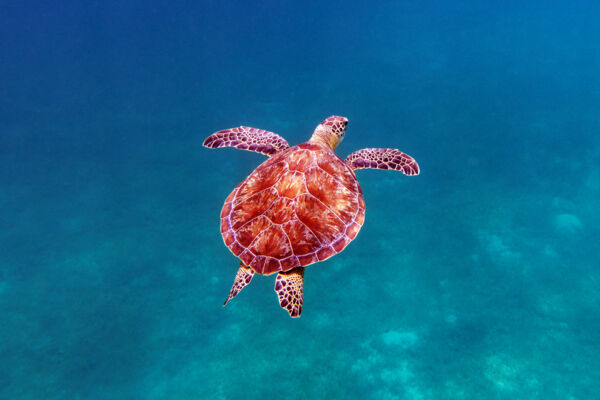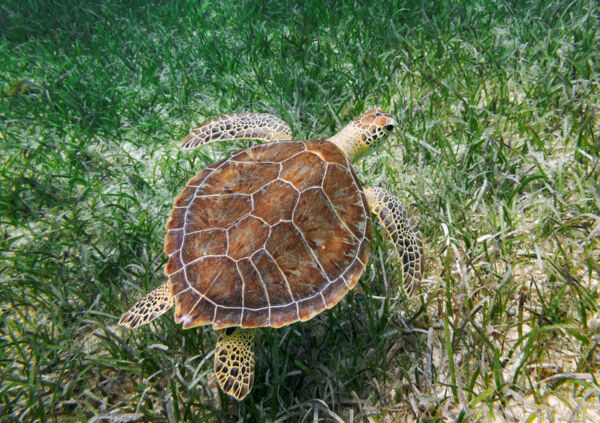Turks and Caicos Sea Turtles
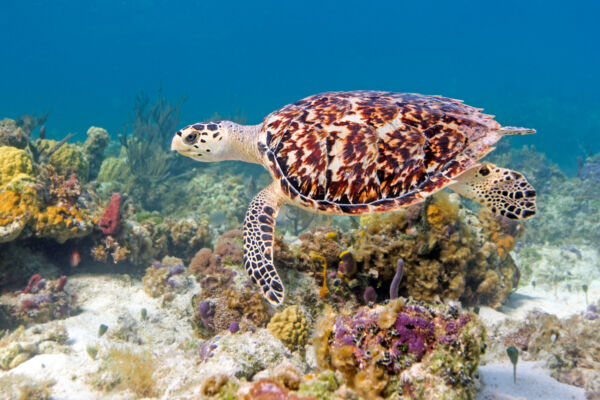
Sea turtles are rather common in the Turks and Caicos Islands. There are two species that you can spot fairly easily by exploring the country’s reefs, seagrass beds, and mangrove channels.
The most common sea turtle species in Turks and Caicos waters are the green turtle (Chelonia mydas) and the hawksbill turtle (Eretmochelys imbricata). Loggerhead turtles (Caretta caretta) are occasionally found here, but sightings are less common.
These graceful, laid-back aquatic reptiles are a treat to see and swim with, especially given that hawksbill turtles are globally critically endangered.
| Hawksbill Turtle | |
| Common name | Hawksbill turtle |
| Binomial name | Eretmochelys imbricata |
| Global conservation status | Critically endangered |
| Conservation status in TCI | Unknown |
| Distribution in TCI | Somewhat common |
| Maximum size | 39 inches (100 cm) shell length |
| Green Turtle | |
| Common name | Green Turtle |
| Binomial name | Chelonia mydas |
| Global conservation status | Least Concern |
| Conservation status in TCI | Unknown |
| Distribution in TCI | Common |
| Maximum size | 43 inches (110 cm) shell length |
The best way to see turtles on your visit to the Turks and Caicos is on a scuba diving or snorkeling trip to the reef, or by kayaking or paddleboarding through the archipelago’s mangrove wetlands, which act as nurseries for turtles and an abundance of other marine life like juvenile sharks, queen conch, and stingrays. The shore snorkeling on Providenciales at Smith’s Reef provides excellent opportunities to swim with green sea turtles and watch them graze on seagrass.
There are no turtle nesting tours in the Turks and Caicos Islands. This is due to the lack of easily accessible nesting sites and that the nesting sea turtle population was largely hunted out many years ago. There are also no captive turtle attractions in the Turks and Caicos Islands. All of the sea turtles in Turks and Caicos are wild.
What Sea Turtles Eat
Hawksbill turtles are omnivores, meaning they eat animals and plants. The hawksbill turtle's diet mainly consists of sea sponges, but it will also eat sea anemones, jellyfish, and even mollusks. Green turtles are mainly herbivores that eat algae and the abundant seagrass found in the shallow offshore environments in the islands.
Where to See Turtles in Turks and Caicos
Often, you don’t have to look very far to find sea turtles here—it’s fairly common to see a turtle’s head pop through the surface when it comes up for air in marinas, canals, and the ocean off certain beaches. While it's unusual to see them while swimming at Grace Bay Beach, sea turtles can often be found at the Bight Reef (Coral Gardens) west of Grace Bay and at Smith’s Reef in Turtle Cove.
If you want to get a closer look at the country’s sea turtles, there are several activities you can do to increase your chances of spotting one.
Snorkeling and Scuba Diving
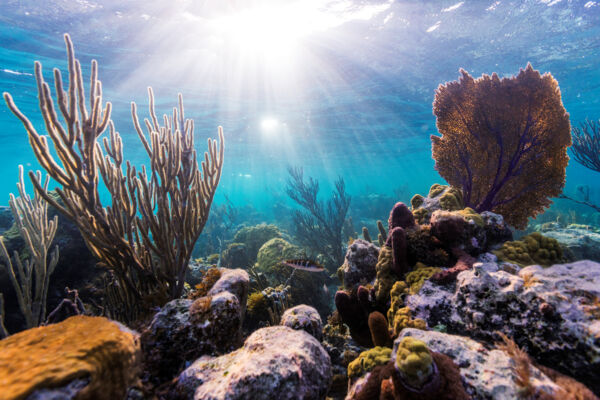
Snorkeling and scuba diving are some of the best ways to see turtles in the Turks and Caicos Islands. Being in the water with these animals is a surreal experience and provides you with the ideal vantage point for observing them (as well as colorful fish and other sea life) up close.
Scuba diving is a great way to see hawksbill turtles, since this species lives on the coral reef and wall diving sites that many local scuba diving companies visit. Great scuba diving is offered on the islands of Providenciales, Grand Turk, South Caicos, and Salt Cay.
Most in-water turtle sightings in the islands tend to be of green turtles, since these turtles graze on the seagrass beds that many snorkelers explore at nearshore snorkeling sites, such as Smith’s Reef and the Bight Reef on Providenciales.
While sightings aren't guaranteed, Providenciales boat cruises often visit snorkeling reefs offshore where you might spot a turtle.
Paddling in the Mangroves
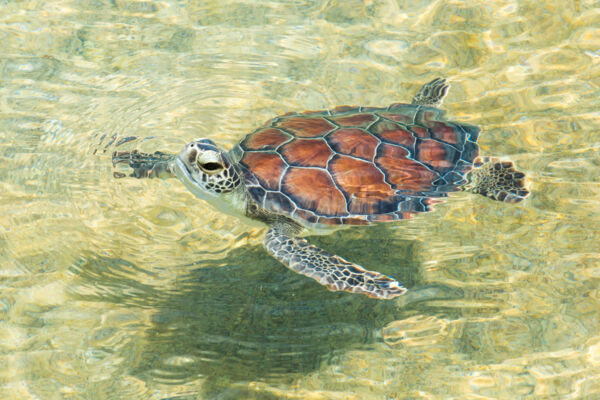
Another great way to see turtles while staying dry is to book a stand-up paddleboarding or kayaking tour through the country’s lush mangroves. The tidal channel on Mangrove Cay near Providenciales allows you to paddle through crystal-clear just a few feet deep alongside friendly green turtles.
Paddleboarding provides the better vantage point of the two sports.
Paddleboarding and kayaking tours are also offered through the more remote mangroves of North and Middle Caicos, as well as South Caicos, but should be booked well ahead of time.
Unusual Sightings
Leatherback turtles have occasionally been seen migrating through the Turks and Caicos Islands on their way to their southern Caribbean nesting grounds. These sightings are rare and have happened offshore.
Nesting Sites
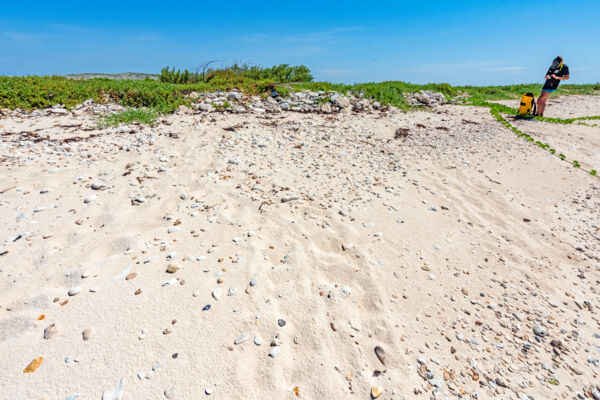
It’s very rare to see a sea turtle nesting on Providenciales, though a few turtles do nest here from time to time. Hawksbills nest more commonly in the islands than green turtles. Most of the sea turtles that visitors see are transient juvenile or young adult turtles, meaning that they hatch and nest elsewhere in the world.
Historically, large numbers of sea turtles laid their eggs on the inhabited islands in the Turks and Caicos Islands. Unfortunately, nesting populations in the country are in decline, and have been for many years. This is likely due to the fact that nesting sea turtles were extensively harvested for their meat, effectively wiping out the original nesting populations.
Today, most sea turtle nesting in the Turks and Caicos happens out of sight on remote cays like Big Sand Cay, which is a critical nesting site for the remnant nesting population of hawksbill turtles.
Sea turtles also nest on North Caicos, South Caicos, and Grand Turk, though in fewer numbers.
Why There Aren’t Any Nesting Tours
There are no turtle nesting tours in the Turks and Caicos Islands, and the lack of these experiences can be attributed to several factors.
Given that much of the nesting population was extirpated by hunting, there aren’t any high-density nesting sites on the inhabited islands. Some of the cays with larger nesting populations are protected sanctuaries that require you to obtain a special permit to land on the island.
Nesting also typically happens at night, making trips to remote islands unfeasible.
Sea Turtle Conservation
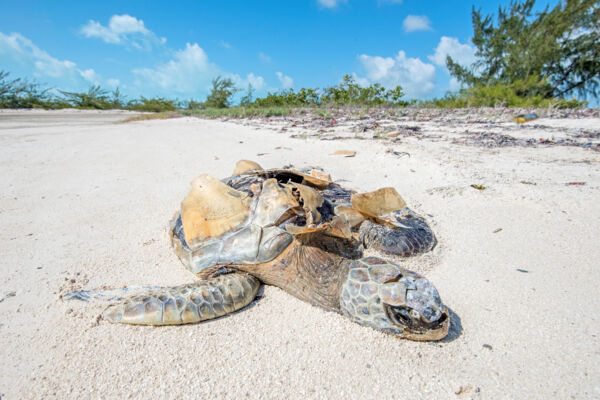
Historic catch levels are not well-documented, but it’s estimated that in the past, hundreds of turtles were harvested each year in the Turks and Caicos Islands. It is still legal to hunt and harvest green turtles and hawksbill turtles in Turks and Caicos, though there are regulations that fishermen must abide by.
In 2008, the Turks and Caicos Islands Turtle Project began as an effort to protect endangered green turtles and critically endangered hawksbills by creating a better-managed local turtle fishery.
The project recommended a number of amendments to the Fisheries Protection Ordinance (1998), including increasing the minimum size of turtle that fishermen can catch, banning the export of turtle products and collection of eggs, and forbidding the capture of any turtle species other than hawksbills and greens. Loggerhead, olive ridley, leatherback, and kemp's ridley sea turtles are protected in the Turks and Caicos Islands. Harvesting these turtles is a criminal offense. These protections came into effect in 2014.
Threats
Boat traffic and jet skis pose a significant threat to the local turtle populations of the Turks and Caicos Islands. Scientists have reported an increase in the number of turtles injured or killed by boat strikes and propellers. Please exercise caution when boating or jet skiing to avoid killing or injuring a sea turtle.
Do not touch turtles in the ocean or on land. If you find an injured or dead turtle, turtle hatchling, or a sea turtle’s nest, report the finding to the Department of Environment and Coastal Resources.
When snorkeling with sea turtles:
- Do not feed them—not only can a turtle bite be painful, but feeding them can disrupt their natural behavior.
- Approach them from the side, so if they need to come up to breathe, they have plenty of room to do so.
- Do not chase the turtle, as this can cause them severe stress.
- Give the turtle plenty of space.
- Be still and quiet. You’ll avoid causing the turtle stress, and they very well may come up to you to get a closer look if they don’t consider you a threat.

